Cap
J-boshi, C-zhen (?)£¬K-¸ðÀÚ
To block the opponent¡¯s advance toward the center by placing a stone two lines above the opponent¡¯s stone.
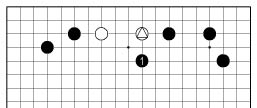 Dia. 1
Dia. 1
Black 1 in Dia. 1 is a cap to the marked white stone.
Knight¡¯s cap
White 1 in Dia.1 is a knight¡¯s cap against the marked black stone.
 Dia. 1
Dia. 1
Large knight¡¯s cap
A move played in a large knight¡¯s relation with a friendly stone that is located on the 4-5 point or the 3-5 point when the opponent approaches it.
White 2 in Dia. 1 and Dia. 2 are the examples.
 Dia. 1
Dia. 1  Dia. 2
Dia. 2
Capture
J-toru (ö¢ªë, ð«ªë), C-ti (ð«)£¬K-µû³»´Ù
To take an opponent¡¯s stone or stones off the board by filling their last liberty.
A stone taken off the board, called captured stone, is kept by the player taking them and used in filling the opponent¡¯s territory at the end of the game.
 Dia. 1
Dia. 1
Counter-capture
J- tori kaesu, C-fan ti (Úãð«), K-µÇµû´Ù
To capture an opponent¡¯s stone that has captured some of the firendly stones.
 Dia. 1
Dia. 1  Dia. 2
Dia. 2
For example, Black 1 in Dia. 1 captures two white stones, and White 2 in Dia. 2 counter-captures that stone.
Captured stone
J-agehama, ageishi (ß¾ª²à´), C-sizi (ÞÝí), K-µû³½ µ¹
A stone taken off the board as having no liberty.
It is also called prisoner or captive.
Cf. dead stone
Capturing race
J-semeai (Íôªáùꪤ), C-duisha (??)£¬K-¼ö»óÀü (â¢ßÓîú)
A local skirmish in which the stones both sides are surrounded and each have at most one eye. Each player is reducing the liberties of their opponent¡¯s stones. The first one to capture the opponent¡¯s stones wins the race and his own stones live.
In Dia. 1 the white and black stones in the corner are caught up in a capturing race. Neither side¡¯s stones have two eyes and each side has to kill the other side¡¯s stones in order to live with his own. If it is Black¡¯s turn now, he wins the race, and vice versa.
 Dia. 1
Dia. 1
While the literal meaning of Japanese term is ¡®attacking each other¡¯ and of Chinese is ¡®killing each other,¡¯ the Korean ¡®¼ö»óÀü¡¯ means ¡®a combat pitting the number of liberties of their stones against the other.¡¯ I think that this explains the situation more clearly.
Carpenter¡¯s square
J-ichigomasu (ìéùêªÞª¹), C-jingui jiao (ÑÑ?ÊÇ)£¬K-µÌ¹ÚÇü
A shape which can occur while settling a group in a corner. The Black position in Dia. 1.
It seems to be large enough to make two eyes but is actually exposed to a danger if White hits the vital point with ¡®a.¡¯
 Dia. 1
Dia. 1
Castle game
J-oshirogo (åÙàòѳ), C-yucheng qi (åÙàòѤ)£¬K-¾î¼º±â (åÙàòѳ)
It is a game played in the presence of the shogun(íâÏÚ) in the castle during the Edo period in Japan.
Center
J-chugen (ñéê«), C-zhongfu (ñéÜÙ), K-Áß¾Ó (ñéäç)
The middle area of the Go board.
We can find a theory which emphasizes the importance of the center in a considerable number of ancient Chinese documents. So far, the emphasis on the center seems to have the philosophical, not technical, origin. The Korean and Chinese terms figuratively compare it to a ¡®belly-ÜÙ¡¯ which is located in the middle of a body but ¡®ÜÙ¡¯ is also supposed to mean ¡®very important¡¯ in Asian language and I think it is related with the theory emphasizing the center.
<¹ÙµÏÆÇ ±×¸²>
Cf. corner, side, zenith.
Chinese opening
J-Chugoku ryu (ñé?×µ), C-zhongguo liu (ñé?×µ), K-Áß±¹·ù (ñé?×µ)
An opening characterized by Black 1 to 5 in Dia. 1.
It is called the Chinese opening because Chinese players often used it during 1960s. It efficiently stakes out a side and aims to build a large territorial framework. It is difficult for White to break into this formation. Black 5 is the ¡®low Chinese opening.¡¯ If Black 5 were at ¡°a,¡± it would be the ¡®high Chinese opening.¡¯
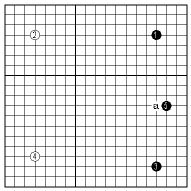 Dia. 1
Dia. 1
Choke
J-atekomi (?ªÆ?ªß) / sashikomi (󬪷?ªß), C-ji (?) / qia (?)£¬K-Âó´Ù
To play at the linking point of the opponent¡¯s stones which are positioned diagonally.
 Dia. 1
Dia. 1  Dia. 2
Dia. 2
It has been called ¡®aim inside¡¯ in English and the translation seems to come from the Japanese terms. However, the Chinese ¡®ji (?) / qia (?)¡¯ literally means ¡®to tighten¡¯ or ¡®to choke¡¯ and they describe the situation quite well
Choosing colors
J-nigiri (äĪê), C-caixian (ãÄà»)£¬K-µ¹ °¡¸®±â
The way the player who takes Black in an even game is decided; that is, the one who plays first.
At the beginning of a game, the stronger or the older player grabs a handful of white stones from the bowl containing the stones and the weaker or the younger guesses whether the number of stones heald by the other is odd or even. When his guess turns out to be right, then he takes Black, and vice versa.
The Japanese ¡®nigiri¡¯ literally means ¡®to grab,¡¯ the Chinese ¡®cai xian¡¯ means ¡®to guess who¡¯s first,¡¯ and the Korean ¡®µ¹ °¡¸®±â¡¯ ¡®stone determining.¡¯
Clamp
J-hasamitsuku (úóªßÜõª¯), C-jia (?)£¬K-³¢¿ö ºÙÀ̱â
An attachment that attacks an enemy stone by squeezing it between two friendly stones.
White 1 in Dia. 1 is an example.
 Dia. 1
Dia. 1
Closing stage
J-shuban (ðûÚï), C-zhongpan (ðûÚï), K-Á¾¹Ý (ðûÚï)
The closing stage of a game is considered to begin when the major fighting has ended and the outlines of both player¡¯s terrritories are almost decided. It ends when all possible endgame moves are played.
In English, the term ¡®endgame¡¯ has been used for both ¡®closing stage¡¯ and a series of moves played in a territorial skirmish. Asian terminology clearly distinguishes between these two terms.
Comb six
See rectanglular six.
Come close to
J-tsumeru(ýþªáªë), C-bi (ùº), K-´Ù°¡¼´Ù
To play a move approaching the opponent¡¯s stone on a side inorder to threaten it and also working as an extension from friendly stone(s).
 Dia. 1
Dia. 1
Black 1 in Dia. 1 is an extension from the black stone in the upper right corner and also coming close to the white stone to make it extend with 2.
It should be distinguished from a ¡®pincer¡¯ that doesn¡¯t allow the opponent¡¯s to have a base, and also doesn¡¯t need to be an extending move from friendly stone(s).
Cf. extend, approach.
Compensation
J-komi (?ªß), C-tiezi (?í)£¬K-´ý
A set number of points given to White for making up his loss which results from Black¡¯s taking the first turn in an even game.
It is usually set 5.5 or 6.5 points in modern Go.
Compromise
J-dakyou (öæúð), no C , K-°¢»ý (ÊÀßæ)
A strategy in a capturing race, which doesn¡¯t run a risk to one¡¯s own life in capturing the opponent¡¯s stones and tries to find a way to co-exist.
The Korean ¡®°¢»ý¡¯literally means ¡®to make a living respectively.¡¯
Compulsory Capture
J-semedoru (Íôªáö¢ªë), no C, K-³õ°í µû´Ù
To be forced to capture the enemy stone(s) already in hand in spite of the loss of points and moves.
In the first diagram, if a black stone is placed at ¡®a¡¯ then Black doesn¡¯t need to add extra moves to capture the three white stones. However, if ¡®a¡¯ is occupied by White, as in Dia. 2, then Black will be forced to capture the white stones with 2 and 4.
 Dia. 1
Dia. 1  Dia. 2
Dia. 2
Conclude
J-kimeru (̽ªáªë), C-dingxing (ïÒúþ)£¬K-°áÁ¤(̽ïÒ)ÇÏ´Ù
To finish off a local area by eliminating all the potential trouble and follow-ups in the position, instead of leaving them for later use.
It is not usually good to do this, except when one is certain of his lead and doesn¡¯t want to leave any kind of uncertainty, even it is favorable to oneself. In Dia. 1 Black 1 concludes the position and eliminates almost all of the potential in this position. Without the exchange of Black 1 and White 2 in Dia. 1, Black has a possibility of playing 1 in Dia. 2.
 Dia. 1
Dia. 1  Dia. 2
Dia. 2
Opp. reserve.
Connect
J-tsugu (ïĪ®¡¢?ª®), C-lianjie (ææïÈ), K-¿¬°á(ææÌ¿)ÇÏ´Ù
To join friendly stones which are separately located.
So far, no fine distinction has been made between ¡®connect¡¯ as a general term denoting all kinds of moves that join stones with each other and ¡®link¡¯ as a term specially indicating a move that physically puts stones into contact with each other. However, to connect stones does not only mean to put them together in contact. For example, the two stones in a diagonal move don¡¯t touch each other, but they cannot be disconnected if proper measures are taken. In this case the stones are also considered ¡®connected.¡¯
Knight¡¯s connection
J-keima tsugi (ÌýØ©ïĪ®), C-fei bu (Þ«?), K-³¯ÀÏÀÚ ¿¬°á
A knight¡¯s move that defends a cutting point.
The knight¡¯s move of Black 1 in Dia. 1 defends against a cut at ¡®a.¡¯
 Dia. 1
Dia. 1
Solid connection
J-katatsugi (̱?ª®), C-danzhan (?ïÄ), K-²ËÀÌÀ½
A play that defends a cutting point by linking the stones as White 1 does in Dia. 1.
 Dia. 1
Dia. 1
Tiger¡¯s connection
J-kaketsugi (ÎЪ±ïĪ®), C-hukou (ûÛÏ¢), K-È£±¸(ûÛÏ¢) ¿¬°á
A way of defending a cutting point with a diagonal play.
 Dia. 1
Dia. 1
White 1 in Dia. defends the cutting point at ¡®a¡¯ with a tiger¡¯s connection.
There are another English terms such as ¡®hanging connection¡¯ and ¡®diagonal connection.¡¯ The ¡®tiger¡¯s connection¡¯ is translated literally from the Chinese and the Korean terms.
Double tiger¡¯s connection
J- rappa tsugi («é«Ã«Ñ?ª®), C-shuang hukou (?ûÛÏ¢), K-¾çÈ£±¸ (å»ûÛÏ¢) ¿¬°á
 Dia. 1
Dia. 1
Blak 1 in Dia. 1 defends the cutting points at ¡®a¡¯ and ¡®b¡¯ simultaneously.
Continuous atari
J-batabata («Ð«¿«Ð«¿), tonton («È«ó«È«ó), oiotoshi (õÚª¤ÕªªÈª·), C?jiebugui (ïÈÜô?), zhuisha (õÚ?), K-ÃËÃ˼ö, ¿¬´Ü¼ö (ææÓ¤â¢)
A move where a connection to save a small part of a group in atari leads to another atari of an even larger group that includes the former one.
Therefore if a part of a group is caught in continuous atari, it has to be given up to avoid further damage.
 Dia. 1
Dia. 1  Dia. 2
Dia. 2
In Chinese terminology, they classify the situation with subject of an action. Namely, ¡®jiebugui(ïÈÜô?)¡¯ explains the situation where the player in atari. Black cannot connect at 2 in Dia. 1, because an even larger group will be killed. While, ¡®zhui sha(õÚ?)¡¯ means the player who gives atari to the opponent. White plays successive ataris with 3 and 5 in Dia. 2 and kills the black stones.
¡®Connect-and-die¡¯ has also been used for this situation, and that is a translation from the Chinese ¡®jiebugui(ïÈÜô?),¡¯ while, ¡®continuous atari¡¯ is translated from the Korean ¡®¿¬´Ü¼ö (ææÓ¤â¢),¡¯ Chinese ¡®zhui sha(õÚ?),¡¯ and the Japanese ¡®oiotoshi(õÚª¤ÕªªÈª·).¡¯ The other words such as the Korean ¡®ÃËÃ˼ö¡¯ and the Japanese ¡®batabata¡¯ describe the player¡¯s action of giving atari with an onomatopoeic term. Both the ¡®ÃËÃË¡¯ and ¡®batabata¡¯ imitate the sound of wood chopping.
Corner
J-sumi (éê), C-jiao (ÊÇ)£¬K-±Í
An area of the board where two sides meet.
The corners are strategically important for settling stones or earning profit because only two walls are needed to stake out territory there. There are four corners on the board: the upper-right, the upper-left, the lower-right, and the lower-left.
<¹ÙµÏÆÇ ±×¸²>
Cosmic Style
J-uchuryu (éÔñµ×µ), C-yuzhou liu (éÔñµ×µ), K-¿ìÁÖ·ù (éÔñµ×µ)
An opening style pioneered and preferred by Japanese professional Takemiya Masaki. The most obvious characteristics of his style are use of the three-star formation and the consistent use of large-scale frameworks.
The game shown below was played in 1990 between Takemiya as Black and Kim, Soojang of Korea.
 Dia. 1
Dia. 1
Counter-atari
See atari.
Counter-bend
See bend.
Counter-capture
See capture.
Counter-cut
See cut.
Counter-pincer
See pincer.
Counting
J-keisan (ͪߩ), C-shumu (â¦ÙÍ), K-°è°¡ (ͪʫ)
To enumerate the pointsof territory that the players gained in a game.
It is usually done at the end of a game in order to decide the winner. However, the players mentally do this many times during a game in order to make a strategy.
Cover
J-fusa (Üæáð), C- feng (?) / zhao (Üæ), K-¾º¿ì´Ù
To put a stone more than two lines upper the enemy stones to prevent them from coming out toward center.
 Dia. 1
Dia. 1
Black 1 to 5 covers the white stones.
Crane¡¯s nest
J-tsuru no sugomori (ùͪÎᵪ´ªâªê), C-wugui bu chutou (??Üôõó?)£¬K-È£¸®º´
A shape in which three stones are surrounded by the opponent as the Blacks in Dia. 1 and killed by the sequence shown in the next diagrams.
The Chinese term means a ¡®turtle¡¯s head that doesn¡¯t come out.¡¯
 Dia. 1
Dia. 1  Dia. 2
Dia. 2  Dia. 3
Dia. 3
Crawl
J-hai (îϪ¤), C-pa (÷ð)£¬K-±â´Ù
To play along the first or the second line under enemy stones.
It is not good to crawl because it helps the opponent build a strong wall and gets little profit.
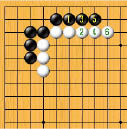 Dia. 1
Dia. 1
Black 1, 3, and 5 are crawling along the second line.
Cross
J-wataru (Ô¤ªë), C-duguo (Ô¤?), K-°Ç³Ê°¡´Ù
To pass over the opponent¡¯s stones in order to connect with an isolated friendly stone, usually using the space near the edge of the board.
The literal meaning o all the three Asian terms is ¡®walk across.¡¯
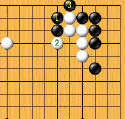 Dia. 1
Dia. 1  Dia. 2
Dia. 2
Black 3 in Dia. 3 and Black 1 in Dia. 2 are examples of ¡®crossing.¡¯
¡®Bridge¡¯ is also used in the English usage.
Knight¡¯s crossing
J-keima watari (ÌýØ©ªïª¿ªê), C-feidu (?Ô¤)£¬K-³¯ÀÏÀÚ °Ç³Ê±â
A knight¡¯s move that connects two groups of stones.
 Dia. 1
Dia. 1
Black 1 in Dia. 1 connects his two stones on the left with the stones on the right.
Crosscut
J-kirichigau (ï·êÞª¦), C-niuduan (?Ó¨), K-¸Â²÷´Ù
To cut the opponent¡¯s bend as White 1 in Dia. 1 resulting in the separation of the stones of both players.
 Dia. 1
Dia. 1
It is distinguished from a normal cut which usually doesn¡¯t run a risk of friendly stones.
Crude play
J-zokusuji (áÔÐÉ), C-sushou (áÔâ¢)£¬K-¼Ó¼ö (áÔâ¢)
A bad move, or a series of bad moves, that looks skillful, but actually is not.
Black 1 in Dia. 1 seems to be a good move because it reduces the White¡¯s territory in the corner and takes profit as shown in Dia. 2. However, it is actually a crude move because it is not taking a global view of the board. It is much better to simply attach at 1 as in Dia. 3 and force White to make eyes with 4 and 6, then to take a good point at 7, a big endgame move against White¡¯s territory on the side.
 Dia. 1
Dia. 1  Dia. 2
Dia. 2
 Dia. 3
Dia. 3
Cut
J-kiru (ï·ªë), C-duan (?)£¬K-²÷´Ù
To separate the opponent¡¯s stones, which are related with a bend, with Black 1 in Dia. 1.
 Dia. 1
Dia. 1
Counter-cut
J-kirikaesu (ï·ªêÚ÷ª¹), C-fan duan (Úã?)£¬K-µÇ²÷´Ù
A cut in response to a cut.
 Dia. 1
Dia. 1
The cut of Black 2 in Dia. 1 responds to the cut of White 1.
Cut-and-kill
J-kiritoru (ï·ªêö¢ªë), C-duan chi (?ýÞ)£¬K-²÷¾î Àâ´Ù
To cut off the opponent¡¯s stone(s) when the cutting is killing as well.
 Dia. 1
Dia. 1
White 1 in Dia. 1 cuts off the black stones on the second line and kills it as well.
Cutback
J-ishi no shita (à´ªÎù»), C-daotuoxue (Óî?ü¨)£¬K-ÈÄÀý¼ö (ýï·â¢)
A sacrifice tactic that lets the opponent capture some friendly stones, but then cuts and captures the opponent¡¯s stones in return. In the diagrams below, Black sacrifices four of his stones. After Black 6 in Dia. 3, White captures four stones with 7 in Dia. 4. but Black can come back and cut and kill two white stones with 8. Black now has two eyes
 Dia. 1
Dia. 1  Dia. 2
Dia. 2
 Dia. 3
Dia. 3  Dia. 4
Dia. 4
This is also called ¡®under the stones¡¯ in English because that is the literal meaning of the Japanese word ¡®ishinoshita.¡¯ However, because the Korean ¡®ÈÄÀý¼ö,¡¯ which literally means ¡®a play that cuts afterward,¡¯ is a more accurate description, I suggest the use of ¡®cutback¡¯ for this kind of sequence. I got the idea for using this word by analogy with ¡®snapback.¡¯
Cut through
J-degiri (õóï·ªê), C-chongduan (?Ó¨), K-³ª°¡ ²÷´Ù
A cutting tactic that uses the cutting points created when the opponent blocks a thrust.
 Dia. 1
Dia. 1
White 1 is a thrust and 3 is a cut.
Dan
J-dan (Ó«), C-dan (Ó«), K-dan (Ó«),
A ranking scale more advanced than kyu, running from 1-dan to 9-dan.
Dansoo (K)
See atari.
Dead
J-shini (ÞݪË), C-si (ÞÝ), K-Á×Àº
A state in which stones cannot live.
In contrast to stones that are alive, dead stones have neither two separate eyes nor the possibility of making them. There is a specific case of stones being dead in which stones are taken from the board when their last liberty is filled. Stones like that are called ¡®captured.¡¯
 Dia. 1
Dia. 1
The Black stones in Dia. 1 cannot make two separate eyes, so they are dead. Note that the point ¡®a¡¯ is a false eye.
 Dia. 2
Dia. 2
The two marked white stones in Dia. 2 are dead because there is no possibility for them to make two eyes.
Decided territory
J-kakutei ji (ü¬ïÒò¢), C-shikong (ãùÍö), K-È®Á¤°¡ (ü¬ïÒÊ«)
Territory in which no potential trouble and no danger of being invaded remains.
 Dia. 1
Dia. 1
A framework becomes a perfect territory only when a game is over, but during a game there is a time when it is useful to know how many points the each side has. To know this, we have to count only decided territory to avoid miscounting. For example, the corner framework of Black in Dia. 1 can be said to have 14 points of decided territory because it is almost impossible for White to reduce it to less than that.
Deep
J-fukai (䢪¤), C-shen (ä¢), K-±íÀº
Going too far into the opponent¡¯s area of influence to reduce it and being unable to easily escape.
 Dia. 1
Dia. 1  Dia. 2
Dia. 2
White 1 or ¡®a¡¯ in Dia. 1 can be a proper reduction, while White 1 in Dia. 2 is too deep and can¡¯t come out from Black¡¯s area.
Defend
J-fusegu (ÛÁª°), C-fangshou (ÛÁáú), K-¼öºñ(áúÝá)ÇÏ´Ù / ÁöÅ°´Ù
To protect stones or territorial framework of one¡¯s own from the opponent¡¯s attack or invasion.
Opp. attack
Descend
J-sagaru (ù»ª¬ªë) / tachu (í¡ªÄ), C-li (Ø¡), K-³»·Á¼´Ù
To stretch down toward the edge at the first or the second line.
 Dia. 1
Dia. 1  Dia. 2
Dia. 2
Especially a descent to the first line can be a brilliant move. For example, Black 1 in Dia. 2 is aiming at both saving the three black stones in the corner and the big endgame move at ¡®a¡¯ and so it is sometimes called by a specific name. In Japan, a descent to the first line as Black 1 in Dia. 2 is called ¡®stand (tachuØ¡ªÄ)¡¯ instead of ¡®descend (sagaru).¡¯ By contrast, in China, they call it always ¡®stand (li)¡¯ and in Korea only ¡®descend and stand (³»·Á¼´Ù)¡¯.
Diagonal move
J-kosumi (á³ôÓ), C-jian (ôÓ), K-¸¶´Ã¸ð, ÀÔ±¸ÀÚ [Ï¢]
A move diagonally adjacent to a friendly stone, or the shape that is made by a diagonal move.
 Dia. 1
Dia. 1
Diagonal attachment
See attach.
Diagonal connection
See tiger¡¯s connection.
Diagonal enclosure
See enclose.
Diagonal jump
See large diagonal move.
Diagonal opening
J-tasuki gata (úþ), C-duijiao buju (?ÊÇøÖÏÑ)£¬K-´ë°¢Æ÷¼® (ÓßÊÇøÖà´)
An opening style in which Black and White both make their initial plays on the diagonally opposite corners.
 Dia. 1
Dia. 1
As long as the stones of one side keep the diagonal relation, it doesn¡¯t matter whether a stone is played 3-3 point, star-point, or 3-4 point etc.
Dipping knight¡¯s move
J-nagare keima (×µªìÌýØ©), C-xiaogui kanmen (á³Ð¡Ê×?)£¬K-óÁø ³¯ÀÏÀÚ
A knight¡¯s move that is made toward the edge of the board as Black 1 in Dia. 1.
 Dia. 1
Dia. 1
The Chinese ¡®xiao gui kan men (á³Ð¡Ê×?)¡¯ means ¡®a little goblin who watches a gate.¡¯ It has been also called ¡®foot sweep¡¯ in English.
Direct ko
See ko.
Distance
Distribution
J-haiseki (ÛÕà´), C-peizhi (ÛÕöÇ), K-¹è¼® (ÛÕà´),
1. The shape how stones are positioned.
 Dia. 1
Dia. 1
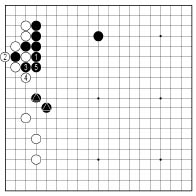 Dia. 2
Dia. 2
The sequence shown in Dia. 1 would be normal if the two marked black stones were not on the board. In this position, the two stones would be isolated on the left side when White pushes up with 4. Therefore, Black 1 in Dia. 2 is the correct move. It takes into consideration the two marked stones that work with Black¡¯s stones at 1, 3, and 5 to build a large framework toward the top and the center. Thus, the distribution of stones is an important consideration to decide where and how to play.
Divide
J-wariutsu (ùܪêöèªÄ), C-fentou (ÝÂ÷á), K-°¥¶óÄ¡´Ù
To occupy an empty area on a side where the opponent made a loose framework in order to prevent it from becoming one big framework.
 Dia. 1
Dia. 1
In Dia. 1 White 1 divides Black¡¯s formation into two which could have been one big territorial framework
Double approach
See approach.
Double-atari
See atari.
Double-bend
See bend.
Double-ko
J-ryoko (?̤), C-shuangjie xunhuan (?̤âà?)£¬K-¾çÆÐ
Two kos which serve the same purpose, happening simultaneously in the same place, and working as a substitute for each other.
 Dia. 1
Dia. 1
In Dia. 1, if White wants to capture the black stones, he has to make ¡®a¡¯ a false eye. However, White should play a ko threat and come back to play ¡®¡â,¡¯ while Black can just play ¡®b¡¯ without playing his ko threat. Therefore, it is impossible for White to win this ko or kill Black. However, if there happens another ko on the board, it could give White a big supply of ko threats.
Double-ko dual life
J-ryoko seki (?̤ò¥), no C, K-¾çÆÐ ºò
A situation that is considered to be a dual life because it contains a double-ko.
 Dia. 1
Dia. 1
The black and white stones in Dia. 1 don¡¯t have two eyes, but one cannot kill the other because there is a double-ko. They are considered to be alive in seki.
Double self-ataris
See self-atari.
Double tiger¡¯s connection
See connect.
Double tiger¡¯s mouth
See tiger¡¯s mouth.
Draw
J-jigo (ò¥Ñ³), C-heqi (ûúѤ)£¬K-ºò
A draw is the result of a game in which both players have the same number of points of territory. The convention of adding ¨ö point to all compensations was invented to prevent this.
Cf. no result.
Draw back
See pull back.
Drive
J-aoru (࿪ë), C-gongbi (Íôùº), K-¸ô´Ù
To force the opponent¡¯s stones to run in a certain direction by threatening it.
It is a knack to make the opponent hurry to escape and be unable to make two separate eyes or a base. As a result, the stones driven become in danger of being a big unsettled group.
 Dia. 1
Dia. 1
In Dia. 1, White is driving the black stones out into the center with the sequence to 15.
Dual life
J-seki (ò¥), C-shuanghuo (äªüÀ), K-ºò
A situation in which two combined opposing groups without two eyes can¡¯t kill each other because the internal liberties can¡¯t be filled, so both are considered to be alive.
The charater for the Japanese ¡®seki¡¯ is ¡®ò¥¡¯ which literally means ¡®to possess.¡¯ The Korean ¡®ºò¡¯ is derived from the Korean ¡®ºñ±è¡¯ which means a ¡®draw.¡¯ However the Chinese ¡®shuanghuo(äªüÀ)¡¯ has the meaning of ¡®both parties are alive¡¯ and gives a clear idea of what the situation is. Therefore I chose ¡®dual life¡¯ as a translation of the Chinese term.
 Dia. 1
Dia. 1  Dia. 2
Dia. 2
Both diagrams show examples of dual life.
Dual life with a bend
J-hane-seki (Ô¯ªÍò¥), no C, K-Á¥Èû ºò
A rare position shown in Dia. 1.
In Dia. 1, both of the Black and White stones are alive in a seki, because neither player can play at ¡®a,¡¯ so the position should remain as it is.
 Dia. 1
Dia. 1
If Black captures three white stones by playing at ¡®a¡¯, then his group loses the capturing race because the eye space of the Black stones is smaller than the eye space of the White stoens. On the contrary, if White plays ¡®a¡¯, then Black will recapture four white stones, so the White stones in the corner will have fewer liberties the Black stones, so White will lose the capturing race that will follow.
Dumpling
J-dango (?í), C-tuanzi (Ó¥í) / ningxing (ëêû¡)£¬K-ÀÀÇü (ëêû¡) / Æ÷µµ¼ÛÀÌ
A clump of stones with no eyes that are not surrounding territory. An in inefficient use of stones.
 Dia. 1
Dia. 1
The shape of White in Dia. 1 is a dumpling.
The Korean ¡®Æ÷µµ¼ÛÀÌ¡¯ literally means ¡®bunch of grapes.¡¯ The translation of ¡®dumpling¡¯ comes from the Chinese and the Japanese ¡®Ó¥í.¡¯
Cf. over-concentration






